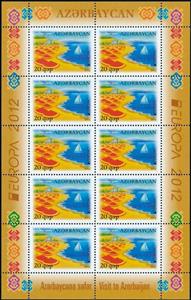Mini Sheet: EUROPA Tourism (Tourism promotion) (Azerbaijan 2012)
EUROPA Tourism (Tourism promotion) (Azerbaijan 2012)
15 March (Azerbaijan ) within release Europa (C.E.P.T.) 2012 - Visit Azerbaijan goes into circulation Mini Sheet EUROPA Tourism (Tourism promotion) face value 10*20 Azerbaijani qəpik
| Mini Sheet EUROPA Tourism (Tourism promotion) in catalogues | |
|---|---|
| Michel: | Mi: AZ 915AKB |
Mini Sheet is square format.
Also in the issue Europa (C.E.P.T.) 2012 - Visit Azerbaijan:
- Stamp - EUROPA Tourism (Tourism promotion) face value 20;
- Mini Sheet - EUROPA Tourism (Tourism promotion) face value 10*20;
- Stamp - EUROPA Tourism (Tourism promotion) face value 60;
- Mini Sheet - EUROPA Tourism (Tourism promotion) face value 10*60;
- Stamp - EUROPA Tourism (Tourism promotion) face value 20;
- Stamp - EUROPA Tourism (Tourism promotion) face value 60;
- Mini Sheet - EUROPA Tourism (Tourism promotion) face value 10*20;
- Mini Sheet - EUROPA Tourism (Tourism promotion) face value 10*60;
- Booklet - EUROPA Tourism (Tourism promotion) face value 320;
- Booklet Pane - EUROPA Tourism (Tourism promotion) face value 320;
- Stamp - EUROPA Tourism (Tourism promotion) face value 20;
- Stamp - EUROPA Tourism (Tourism promotion) face value 60;
- Souvenir Sheet - Europa - Tourism - Baku International Airport face value 1;
Mini Sheet EUROPA Tourism (Tourism promotion) it reflects the thematic directions:
An aircraft (pl. aircraft) is a vehicle that is able to fly by gaining support from the air. It counters the force of gravity by using either static lift or the dynamic lift of an airfoil, or, in a few cases, direct downward thrust from its engines. Common examples of aircraft include airplanes, rotorcraft (including helicopters), airships (including blimps), gliders, paramotors, and hot air balloons.Part 1 (Definitions and Abbreviations) of Subchapter A of Chapter I of Title 14 of the U. S. Code of Federal Regulations states that aircraft "means a device that is used or intended to be used for flight in the air."
Aviation is the practical aspect or art of aeronautics, being the design, development, production, operation and use of aircraft, especially heavier than air aircraft. The word aviation was coined by French writer and former naval officer Gabriel La Landelle in 1863, from the verb avier (synonymous flying), itself derived from the Latin word avis ("bird") and the suffix -ation.
A lake is a naturally occurring, relatively large and fixed body of water on the Earth's surface. It is localized in a basin or interconnected basins surrounded by dry land. Lakes lie completely on land and are separate from the ocean, although they may be connected with the ocean by rivers, such as Lake Ontario. Most lakes are freshwater and account for almost all the world's surface freshwater, but some are salt lakes with salinities even higher than that of seawater. Lakes vary significantly in surface area and volume.
A modern sailing ship or sailship is any large wind-powered vessel. Traditionally a sailing ship (or simply ship) is a sailing vessel that carries three or more masts with square sails on each. Large sailing vessels that are not ship-rigged may be more precisely referred to by their sail rig, such as schooner, barque (also spelled "bark"), brig, barkentine, brigantine or sloop. There are many different types of sailing ships, but they all have certain basic things in common. Every sailing ship has a hull, rigging and at least one mast to hold up the sails that use the wind to power the ship. The crew who sail a ship are called sailors or hands. They take turns to take the watch, the active managers of the ship and her performance for a period. Watches are traditionally four hours long. Some sailing ships use traditional ship's bells to tell the time and regulate the watch system, with the bell being rung once for every half hour into the watch and rung eight times at watch end (a four-hour watch). Ocean journeys by sailing ship can take many months, and a common hazard is becoming becalmed because of lack of wind, or being blown off course by severe storms or winds that do not allow progress in the desired direction. A severe storm could lead to shipwreck, and the loss of all hands. Sailing ships are limited in their maximum size compared to ships with heat engines, so economies of scale are also limited. The heaviest sailing ships (limited to those vessels for which sails were the primary means of propulsion) never exceeded 14,000 tons displacement. Sailing ships are therefore also very limited in the supply capacity of their holds, so they have to plan long voyages carefully to include many stops to take on provisions and, in the days before watermakers, fresh water.
A ship is a large watercraft that travels the world's oceans and other sufficiently deep waterways, carrying passengers or goods, or in support of specialized missions, such as defense, research and fishing. Historically, a "ship" was a sailing vessel with at least three square-rigged masts and a full bowsprit. Ships are generally distinguished from boats, based on size, shape and load capacity.
Tourism is travel for pleasure or business; also the theory and practice of touring, the business of attracting, accommodating, and entertaining tourists, and the business of operating tours. Tourism may be international, or within the traveller's country. The World Tourism Organization defines tourism more generally, in terms which go "beyond the common perception of tourism as being limited to holiday activity only", as people "traveling to and staying in places outside their usual environment for not more than one consecutive year for leisure, business and other purposes". Tourism can be domestic or international, and international tourism has both incoming and outgoing implications on a country's balance of payments. Today, tourism is a major source of income for many countries, and affects the economy of both the source and host countries, in some cases being of vital importance.






